Dulse – Identification, Edibility, Distribution
Palmaria palmata AKA Dillisk
Related pages:
- Identification – 4/5 – A medium sized (10cm-40cm) flat red seaweed that usually looks a rusty purple/brown colour. Irregularly branched and divided lobes.
- Edibility – 4 /5 – With its meaty flavour, dulse is one of the stars of the seaweed world – a clinically proven antioxidant and source of protein, potassium and iodine, making it an excellent food to support hypothyroid disorders – though do go easy if you have an overactive thyroid. It is one of our most nutritionally complete wild foods. Later in its season, and especially in more sheltered locations, dulse can become home to sea mat (Membrainpora membranacea) which appears as pale crusts on the blades. Close inspection (through a hand lens) will show these to be made up of hundreds of tiny craters which are home to minute tentacled filter feeders. These are harmless, but crunchy and not pleasant to eat. They can be scraped off with the back of your nail, but this becomes laborious if you are harvesting any quantity, so its best to avoid settled dulse if possible.
- Habitat – You can find dulse on most rocky shores at any reasonably low tide, but you do need to ensure the tide is fully out to make gathering easy. It hangs in clumps from a small discoid holdfast on rocks, or grows epiphytically on other seaweeds, notably serrated wrack (Fucus serratus) and the large stalks of forest kelp (laminaria hyperborea) .
- Distribution – 5/5 – Very common in suitable habitats within its tidal range. Best picked, as with most seaweeds, where it is washed by strong currents.
- Season – All year round, but at its best slightly later than most seaweeds in June and July (at least where I am!).
- How to harvest – There is very little danger of poisoning yourself through misidentification provided you harvest fresh from the rocks from clean water, as there are no toxic inshore seaweed species. Harvest by cutting up to 2/3rds with a sharp pair of scissors, leaving the holdfast to grow back, or by teasing out clumps when growing epiphytically. See here for more information on safe and sustainable seaweed harvesting.
- How to eat – Dulse has a rich, salty, meaty flavour – it has been marketed as a vegetarian substitute for bacon! It is delicious raw, if a little chewy, and makes an excellent, deeply nourishing on-the-hoof snack. It can also be cooked as a vegetable (excellent in stir-fries) or dried and flaked to use in stocks, soups, breads, sauces – whatever you like really. There are very few savoury dishes it doesn’t improve, especially when dried and powdered. Briefly fried into dulse crisps, it makes an excellent beer snack. It is extremely high in umami, so great for dashi broths and the basis of miso soups. It makes an excellent condiment by dehydrating, stuffing in a jar and topping up with 3-2-1 vinegar (3 parts apple cider vinegar, 2 parts water, 1 part sugar).
Related pages:
For in-depth films on dulse, and lots, lots more, check out my Seaweed Webinar.
“The webinar was amazing! You are a good storyteller. Scientific information, combined with tips and beautiful picturing. 👏” – Kanlenaki on Instagram
“This was absolutely brilliant, thank you so very much for being so generous with your knowledge! The webinar format of videos and live worked fantastically!” – Sarah Hobbs, Webinar chat comments
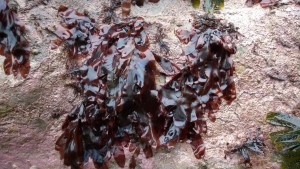
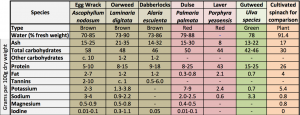
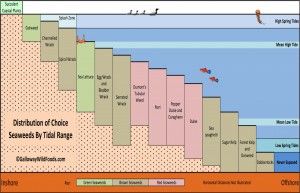
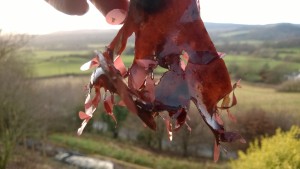
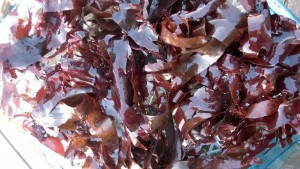
18 Comments
Hi. How can I be sure that the dulse I purchase at a store has been harvested from a clean environment? Is there a cleansing process before it gets to market?
Thanks
You’d need to check that with the suppliers.
Mark have you any tips for powdering it when dried? I baked mine in the oven but my blender can’t get through it.
Yes, it is tough isn’t it!? I usually resort to finely chopping with a very sharp, heavy chef’s knife. I think a thermomix would do the job, if it was freshly toasted.
1. Is dulse the same as dilisk, please?
2. When dried what colour should dulse be, please?
Thanks Mary
Hi Mary.
1. Yes: dulse = dilisk
2. Dulse usually drys to a deep rusty purple colour.
I know this has already been answered but dilisk comes from the Irish for dulse, which is duilleasc. Just in case anyone was interested 🙂
I was, thank you Caodhan 🙂
Hello, love your seaweed infos, thanks.
I’m in Cornwall, and often collect dulse. Lately, at very low tides, I’ve been finding a few big (sort of) leaves of a weed that is the colour of dulse, but much thicker, leathery even.. and without the fronds.
Is this maybe just older dulse, or something else?
I tried some in a bath, and it got really gelatinous!
Cheers for any tips,
Thanks, glad you find it useful.
Sounds like you might have found red rags – Dilsea carnosa.
Interesting to hear about its gelatinous properties. There sdoesn’t seem to be much history of eating it.
Mark
Hi Mark
Your site is a great resource, thank you. Been foraging sleabhac (laver) most of the year and now dulse, gutweed and kelp. Loving all the tastes and nourishment!
Can you tell me is it possible we will be eating last year’s growth with dulse? Or are they like perennials that die back then regrow each year? I’ve found some tough ones!
I’ve a load of seaweed books ordered so will soon know a lot more!
Thank you. Dulse is perennial, with the holdfast persisting. However,in my experience the blades lose vitality and a washed off by storms etc through the winter, with fresh growth starting again in spring. Perhaps you are finding red rags (Dilsea carnosa), which is not dissimilar, but much thicker and tougher.
Great info and you are generous with your knowledge. Still, I wouldn’t quite trust myself to identify things safely. Hopefully, I will find the opportunity to do some of your foraging excursions. When can I book for 2022?
Thanks. Seaweeds are very low risk! I start to list 2022 events in November 2021. 🙂
Where can I harvest it from in the uk please?
Err…did you read the post??!
I found Dulse at low tide attached to another large stem of other seaweed, but this larger stem was not longer attached to anything, is it okay to harvest Dulse to eat in this situation?
Thanks
General advice is to not eat unattached seaweed, including epiphytes on a dead host, but with a little experience this becomes a judgement call. After a storm there is often plenty of good edible seaweed washed up. I can’t advise you on your particular sample though!